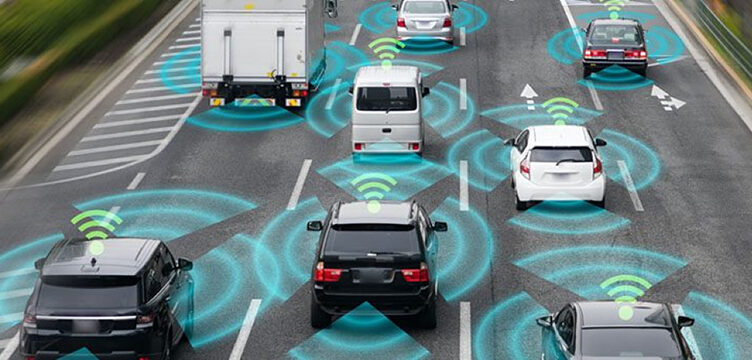While much of the focus for developers of ADAS and AD systems is on vehicle-mounted sensor systems and associated software and hardware stacks, the role for V2X (vehicle to everything) is increasing, with growth most evident in the Asia-Pacific region (APAC).
To gain an overview of the state of play in the V2X field, AVI sat down with Mark Murray, VP sales, GNSS and automotive, and Manfred Lindacher, VP sales, automotive international, from Quectel, which develops among other systems, cellular modules and GNSS systems for automotive. With products in markets around the world, they are well placed to provide an overview of V2X and identify what hurdles remain for its wider adoption.
Murray’s initial observation is that “China is moving forward with CV2X (cellular V2X) and is very much taking the lead in the region, and that is going hand in hand with the adoption of 5G.” However, his European counterpart, Lindacher, notes that in Europe, adoption of a joined-up approach to V2X is still lagging: “It is still somewhat of a technology discussion, with some big players still pushing toward DSRC (dedicated short range communications) rather than cellular systems and there is regulation missing.”
This is an important factor, as the chosen method of V2X communication dictates the hardware requirements and the global trend appears to be toward CV2X. “In the USA and China they are going with cellular V2X technology. So we have developed a quite comprehensive product portfolio such as CV2X modems or even with the functionality embedded in our 5G modems. But as soon as DSRC comes into the game, you’re talking about completely different hardware. However, we are also currently working with a partner who is supporting both DSRC and CV2X,” explains Lindacher.

On a global scale, various vehicle markets are at very different points when it comes to the integration of V2X capabilities. Looking at the work of OEMs that are planning product launches in 2024 or 2025, Murray and Lindacher suggest that most in China are looking to implement CV2X functionality, with the same being true of many in the USA, whereas in Europe, such capabilities will be firmly optional. “No one there is currently planning to produce cars that support CV2X as standard for the European market,” Lindacher observes.
As to why the adoption of V2X remains relatively slow, Murray is convinced that the issue is not hardware: “We can hand a 5G evaluation system to an OEM that supports 5G, GNSS, CV2X and Wi-Fi 6. The issue is cost and it’s regulation.”
In the USA some clarity was provided on this matter at the end of 2020 with the reallocation of much of the 5.9GHz band, which had previously been reserved for DSRC V2X applications, to unlicensed wi-fi. The remaining 30MHz of the 5.9GHz spectrum has been assigned to CV2X applications, with the Federal Communications Commission (FCC) citing that DSRC had failed to establish a foothold and that dedicating the band to a single technology would increase efficiency.
“That has had a very positive impact in the US,” says Murray. “We are seeing a lot more interest from OEMs and those involved in infrastructure like smart city construction.” However, cost remains an issue: “The hardware is there, but it’s very early. So, the prices are high and until the take-up rate increases and economies of scale are there, it will remain expensive. But I think right now, from a purely regulation perspective, we are going in the right direction in North America.”
From the perspective of companies developing autonomous driving services, Murray suggests that to them, V2X is simply another sensor and until infrastructure is in place, they will continue to concentrate on vehicle-based systems. “If we look at the main autonomous vehicle companies we’re working with in the US, they’re not yet interested in CV2X,” he says. “Until there is a majority of cars and infrastructure on the road, it’s not going to be very useful to them, so it is a bit of a catch-22. But there do seem to be plans for the next generation [of vehicles] to be going that way.”

On the purely hardware side of V2X, Lindacher suggest that the demands of manufacturers are changing when it comes to integration within vehicles. “There is currently a trend where we see more and more OEMs are using antenna-based system, typically mounted on the vehicle roof,” he says. “That means we’re moving out of the vehicle interior zone which has an operating temperature range from -40°C to 85°C, typically, to work at a higher temperature range, which can be up to 105-115°C. That is a physical challenge we are facing, and means the systems need to be resistant to those temperatures and remain operational, particularly for functions such as emergency call, which should be immediately available.”
Another area of development Murray flags up is the increasing level of accuracy required from GNSS hardware, particularly when it comes to fully autonomous applications. “It is not just CV2X that has the requirement for accuracy and when you get into Level 3+ and 4 autonomous, you require centimeter-accurate GNSS, which calls for the use of L1 [1,559-1,610Mhz) and L5 (1,151-1,214Mhz) bands. From our perspective there are two ways you can skin that problem. That level of functionality is already present in our cellular module technology or we can also support standalone GNSS. It comes down to the customer’s architecture and how they want to support that functionality.”
Overall, it seems that CV2X is leading the way when it comes to widespread adoption, with China ahead of the pack in its implementation, as highlighted by Baidu’s recent testing of V2X-enabled intersections in major cities. With the USA hot on China’s heels, European vehicle manufacturers and governments risk being left behind in this particular technology race if they do not adopt a unified approach in the near future.


